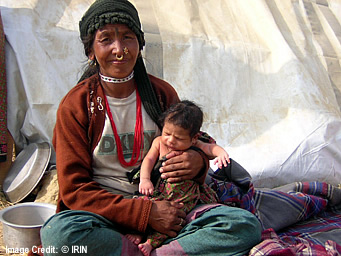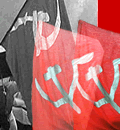|
The
Origins of the Nepalese Maoist Insurgency
|
|
Maoist
Insurgency: Summary
|
 |
 In
February 1996, the CPN-Maoist and its political wing, the Samyukta
Jana Morcha, United People's Front, launched an armed insurgency, declaring
a "People's War" in mid-western Nepal to overthrow the government
and establish a republican communist state. An estimated 9,000 to 10,000
people have since died in the fighting, which has spread to all of Nepal's
75 districts and involved grave human rights abuses on both sides. The
government has dealt with the insurgency as a law and order problem, using
police rather than the army in counter-insurgency operations. In
February 1996, the CPN-Maoist and its political wing, the Samyukta
Jana Morcha, United People's Front, launched an armed insurgency, declaring
a "People's War" in mid-western Nepal to overthrow the government
and establish a republican communist state. An estimated 9,000 to 10,000
people have since died in the fighting, which has spread to all of Nepal's
75 districts and involved grave human rights abuses on both sides. The
government has dealt with the insurgency as a law and order problem, using
police rather than the army in counter-insurgency operations. |
|
Throughout 1999 and early 2000 there were moves to grant the police special powers
and establish paramilitary forces, though these stopped short of deploying
the army.
By
the end of 2001 the Maoist armed groups were believed to have been
involved in violent incidents in nearly all of Nepal's 75 districts, increasing
the security risk to civilians. Among the offences reported are forced
disappearances, abductions, raids, destruction and looting of property,
extortion and other acts of intimidation. The risk of violence and the
collapse of services in the worst affected areas are said to have forced
some families to flee to safer areas. Thousands of persons have been internally
displaced.
The
long-running conflict between the CPN-Maoist and the government forces
became a human rights crisis in 2002, with hundreds of civilians
killed and scores of police officials summarily executed. A State of
Emergency was declared on 26 November 2001, following Maoist
attacks on police and army barracks in Dang and Syangja districts, was
extended on 25 February 2002 and again in May 2002. Political
uncertainty added to the Government's rejection in July 2002 of
an offer for peace talks, on the grounds that armed groups would have to
disarm first, could prove a further threat to the security of the region.
International food aid has been scaled back or completely suspended in
some areas due to security concerns. Experts fear that Nepal may be moving
towards one of the most serious food crises in South Asia.
top
|
Background
and main causes of displacement
|
 |
 |
| The
"People's War" was launched by the Maoists (CPN-M) in 1996 with
the aim of overthrowing the constitutional monarchy and establishing a
socialist republic. Despite the reinstatement of a multiparty democracy
in 1990 and a new constitution, which followed three decades of panchayat
(nonparty) system of government, Nepal's political order continued
to be dominated by the same elite who demonstrated little inclination to
improving the lives and livelihoods of the majority of the rural poor and
largely failed to address the systemic inequality of Nepalese society. |
|
The
insurgency started in the districts of the mid-western region when Maoists
began attacking the police, the main landowners, members of other political
parties, teachers and local government officials. Forced to leave their
land and property or threatened because of their association with the monarchist
regime, many people targeted by the Maoists started moving to district
headquarters where many chose to settle. Using guerrilla tactics and virtually
unchallenged by the government during the first five years, the Maoists
gradually gained ground in other districts of the country. It was not until
the deployment of the army and the declaration of a state of emergency
in late 2001 that the conflict escalated. By then, displacement had also
started to affect other poorer strata of the population who fled fighting
between the rebels and the army, forced recruitment into Maoist ranks and
also the more general effects of war.
In
many areas, the conflict led to the breakdown of education, closure of
businesses, weakening of local economies and interruption of public services.
Insecurity and blockades further reduced the availability of food and exacerbated
a long-standing trend toward rural exodus (SAFHR, March 2005, p. 36). Particularly
after November 2001, when security deteriorated markedly in rural areas,
many people started fleeing to urban district centres, large cities like
Kathmandu, Biratnagar and Nepalgunj, and across the border to India.
In
2001, Prince Gyanendra was crowned king after most of the royal family
was killed in a bizarre shooting incident in the palace. A year later he
suspended the elected Parliament, installed a prime minister of his choosing
and indefinitely postponed elections, effectively assuming full executive
powers with the support of the army. Although a seven-month ceasefire provided
some respite in 2003, fullscale fighting soon resumed, even gaining in
intensity, while the conflict rapidly spread to all 75 districts of the
country. A pattern emerged, with the rebels more or less controlling the
rural areas and the government's presence mainly restricted to district
headquarters and urban centres. In a desperate effort to regain some control
of the rural areas, the government started encouraging the creation of
"village defence committees" in various districts of the country (ICG,
17 February 2004). Often created by local landlords with the tacit support
of the army, these militias constituted an inflammatory development in
the conflict.
In
February 2005, an anti-Maoist rampage in Kapilvastu district resulted in
the displacement of between 20,000 and 30,000 people to the Indian border
(Bell, Thomas, 12 March 2005; BBC, 14 March 2005; Kathmandu Post, 19 March
2005). On 1 February 2005, the king dismissed the government and declared
a state of emergency giving him absolute power and effectively suspending
all civil liberties (AI, 15 June 2005, p. 4).
In
the wake of the coup, fighting and subsequent human rights abuses increased
significantly throughout the country. While the king gained less understanding
for his coup from the international community than he had hoped for, he
also miscalculated the repercussions at the domestic level. By the end
of the year, the Maoists and the main political parties had reached a common
understanding in the form of a 12-point agreement where they approved a
common platform of action for ending the king's absolute rule and restoring
sovereignty to the people through the reinstatement of Parliament, the
formation of an allparty government and elections to a constituent assembly.
On
24 April 2006, following weeks of nationwide protests, the king ended his
direct rule and reinstated parliament (IRIN, 25 April 2006). At the end
of May, a new interim government and the Maoist leadership agreed on a
25-point Code of Conduct to end the conflict and pave the way for the election
of a constituent assembly, whose task would be to draw up a new Constitution
and lay down the foundation of a new political system to govern the country.
Both sides met for a second round of formal peace talks in early October
and agreed to hold elections for a constituent assembly by June 2007. No
agreement was reached on the main bones of contentions, which include the
future of the monarchy and the disarmament of the rebels (IRIN, 10 October
2006).
Credit:
Internal Displacement Monitoring Centre (IDMC) and Norwegian Refugee Council
2006
|
 |
top
 |
 |
External
links |
|







